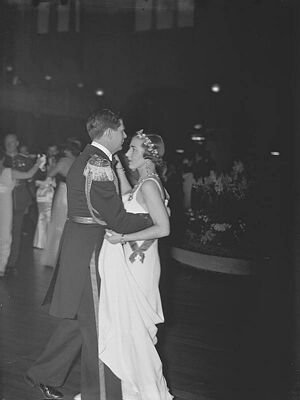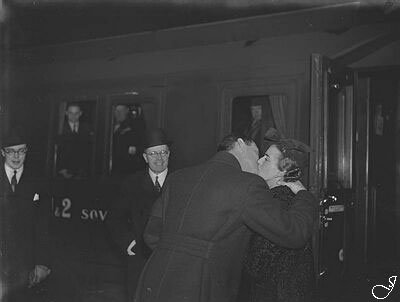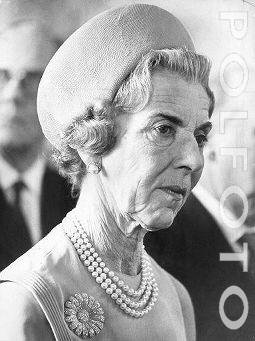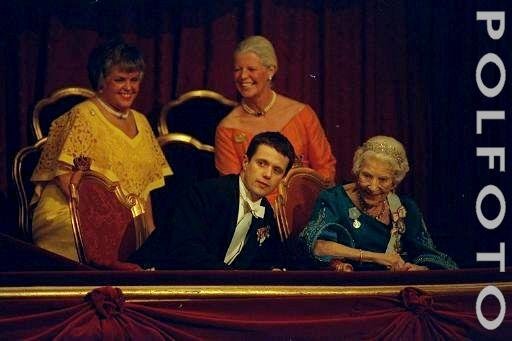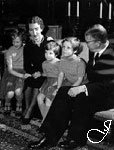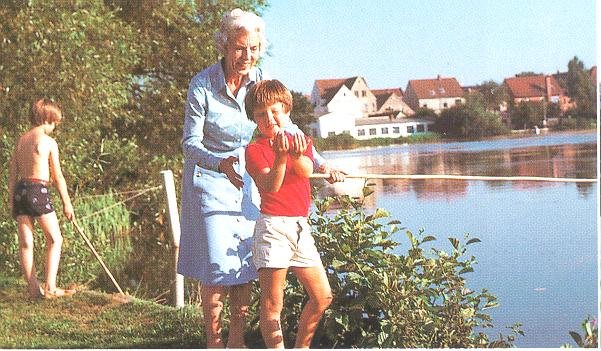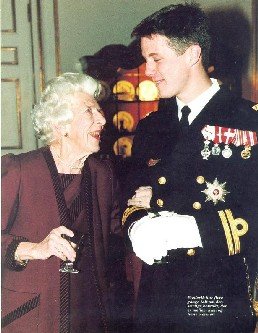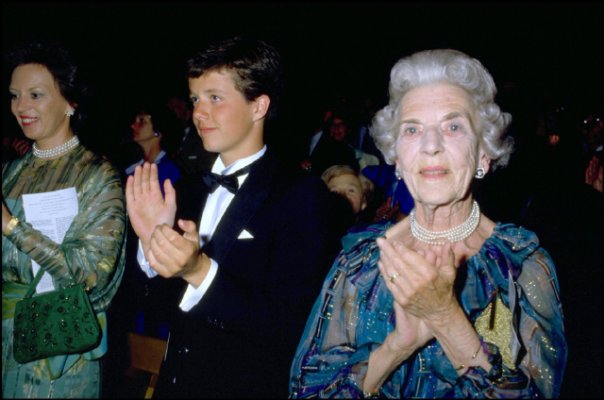Josefine said:
I have tried to find some facts about her as a queen but with no luck to find it in englsih, can someone help me
from news.telegraph
HER MAJESTY QUEEN INGRID OF DENMARK, the widow of King Frederick IX, who has died aged 90, was the daughter of a King, the wife of a King, the aunt of a King and the mother of two Queens.
Her father was King Gustaf VI Adolf of Sweden, and her mother Princess Margaret of Connaught, daughter of Queen Victoria's third son Prince Arthur, Duke of Connaught. She was the mother of Margrethe II, the present Queen of Denmark, and of Queen Anne-Marie of the Hellenes, the wife of King Constantine. She was also an aunt of the present King of Sweden, Carl XVI Gustaf.
Queen Ingrid was born Princess Ingrid Victoria Sofia Louise Margareta of Sweden on March 28, 1910, in Stockholm. Her father, then Crown Prince Gustaf and a captain in the Swedish army, did not become King until he was nearly 70, on the death of his 92-year-old father King Gustaf V in 1950.
Crown Prince Gustaf - an outstanding athlete, a well-respected archaeologist and an authority on Chinese ceramics - was a great-great-grandson of Napoleon's Marshal Jean Baptiste Bernadotte, the French lawyer's son who founded the Swedish Royal House of Bernadotte de Ponte Corvo.
Through her paternal grandmother Queen Victoria (of Sweden), the daughter of Friedrich, Grand Duke of Baden, Princess Ingrid was also descended from the Royal House of Vasa, which in the 16th and 17th centuries gave Sweden some of its greatest monarchs and military leaders.
Princess Ingrid's parents had met in Egypt, in the winter of 1904-05, and were married at Windsor Castle on July 15 1905. Their marriage marked the first union between the British and Swedish royal houses since 1406. They and the five children Princess Margaret bore - Princes Gustaf Adolf, Sigvard, Bertil and Carl Johan, and Princess Ingrid - lived in apartments in the Royal Palace in Stockholm, in a mansion at Ulriksdal, near the capital, and in a summer residence, Sofiero, at Skane, in southern Sweden.
They led, according to the Infanta Eulalia of Spain, "a peaceful and happy existence, wrapt up in each other, and devoted to their rapidly increasing family". Princess Ingrid had a kindly English nurse. Princess Margaret, known to intimates as Daisy, loved gardening and flowers. Whenever there was a royal procession in Sweden, loyal subjects would toss blooms into her passing carriage. On one occasion the carriage had to be stopped, as the infant Princess Ingrid had almost been smothered.
The Crown Princess died on May 1, 1920, when Ingrid was 10. The Crown Prince married, in 1923, his late wife's second cousin, Lady Louise Mountbatten, daughter of the 1st Marquess of Milford Haven. Lady Louise was a great-grand-daughter of Queen Victoria (of Great Britain and Ireland) and a niece of the last Tsarina of Russia, her mother's sister. Her brother Louis would become Viceroy of India and Earl Mountbatten of Burma.
Princess Ingrid was educated in Sweden, but along thoroughly English lines, mapped out in London by Queen Mary. Her attitudes and interests would be very much those of a British princess; in particular, she was keen on sport - riding, swimming, skating, skiing and lawn tennis.
She spent long periods of her youth in England, staying with her adoring grandfather Connaught at Clarence House in London, and in Surrey at Bagshot Park (the house now occupied by the Earl and Countess of Wessex). In 1919, Ingrid was a bridesmaid at the marriage, in Westminster Abbey, of her aunt Princess Patricia of Connaught to Commander (later Admiral) Alexander Ramsay - the first Royal wedding of a Princess to a commoner. In 1928 Princess Ingrid made her first appearance at Court in Stockholm, and came to England for her first London season; in 1931 she was a bridesmaid at the marriage of Lady May Cambridge to Captain Henry Abel Smith.
It was said in her family that Ingrid longed to be a Queen, and in 1933 she appeared in the title role of a play called A Queen for a Day, performed in Stockholm's town hall. So as to help her get under the skin of her part, she wore a dress and train which had belonged to the Empress Josephine (an ancestress of hers), and the Empress's diadem, necklace and earrings.
The British press noted that she was "one of the few eligible Protestant princesses in Europe - a typical Scandinavian beauty, tall and graceful, with blue-grey eyes and shingled golden hair". Moreover, in the early 1930s she was evidently interested when the idea was floated that she might make a suitable bride for her second cousin David, the Prince of Wales (later Edward VIII).
Rumours, in 1933, that she might become engaged to George V's youngest son Prince George, later to be the Duke of Kent, were firmly denied, and in 1934 Princess Ingrid was one of bridesmaids at his wedding to Princess Marina. In the event, Ingrid married, on May 24, 1935, Crown Prince Frederick of Denmark, eldest son of King Christian X, the third monarch of the Schleswig-Holstein-Sonderburg-Glucksburg branch of the house of Oldenburg. The marriage, which took place in the Storkyrkan church beside the Royal Palace in Stockholm, was attended by three Kings and more than 60 Princes and Princesses.
Until his marriage, the 6ft 6in tall Crown Prince had been a regular officer in the Danish navy; he had worked his way up from cadet to rear-admiral - and had collected a variety of tattoos on the way. He was also a good pianist, and a gifted amateur conductor, especially of the Royal Theatre Orchestra.
It had been planned that Crown Prince Frederick should marry his cousin Princess Olga of Greece, niece of King Constantine I; but, after the wedding had been twice postponed, the betrothal was broken off. (Princess Olga liked the Prince, but had been disconcerted when, during their courtship, he had unscrewed one of his teeth and placed it on the table between them.)
King Christian is said to have been a domestic tyrant, a stern and unbending figure whose two sons went in dread of him. But Princess Ingrid, used to dealing tactfully with stiff-necked old gentlemen at the Royal Court in Stockholm, stood up to her father-in-law and won his affection. This would prove an invaluable asset when, due to the King's incapacity during the Second World War, the Crown Prince found himself acting as Denmark's Regent.
The young couple's principal residence was a palace at Charlottelund, where a kennel was built for the Crown Princess's black Scottie dog Humpty. Their first child, Princess Margrethe - known, like her grandmother Margaret, as Daisy - was born in Copenhagen on April 16, 1940, one week after the German invasion of Denmark. Princess Ingrid wheeled the baby in her perambulator through the capital's streets, in symbolic defiance of the occupying forces.
Two more daughters followed during the Occupation years, Princess Benedicte (who later married the 6th Prince zu Sayn-Wittgenstein-Berleburg) and Princess (now Queen) Anne-Marie. After education at home with British and French governesses, the princesses attended schools with other children.
King Christian X died on April 20, 1947, and the next day the Crown Prince was proclaimed King Frederick IX from the balcony of the Christiansborg Palace. When Queen Ingrid joined the King on the balcony, he kissed her publicly in front of the crowd, "with a touch", noted the British Ambassador, "which augurs well for the popularity of his reign".
The Danish royal family has a claim to be the oldest reigning in Europe, tracing its history back to Gorm the Old, who united the country and ruled as the first Danish king in the 10th century. Since 1849, though, Denmark has been a constitutional monarchy, and King Frederick, like his father, was content to confine his role to presiding over weekly meetings of the Council of State, and putting his signature to draft legislation and service appointments.
While the Amalienborg Palace remained the King and Queen's official residence, the Royal Family moved into Fredensborg Castle, which King Christian had occupied only for three or four weeks a year during the autumn shooting season, and which during the Occupation had stood empty. In the summer the family stayed at Grasten Palace in southern Jutland, and they had a modest hunting lodge where they liked to spend Christmas.
The King and Queen introduced a notably unstuffy style of monarchy. The King was a familiar figure bicycling around Copenghagen, and he and Queen Ingrid would visit art exhibitions, restaurants and the theatre, just as any of their subjects might do. They did, though, maintain the tradition of riding through the streets of Copenhagen in a glass coach on New Year's Day.
After King Frederick's death in 1972, Queen Ingrid continued to live at Fredensborg Castle, and to take part in the life, public as well as private, of the Danish royal family.


